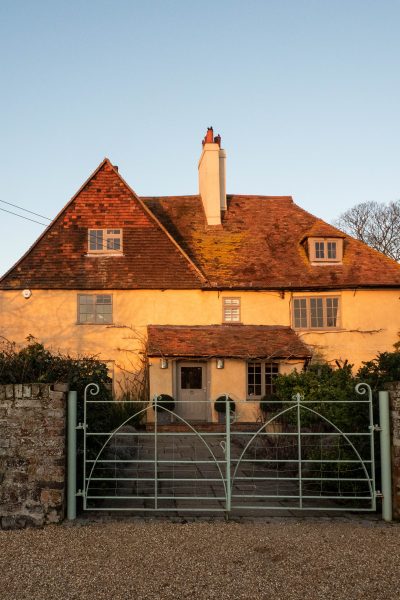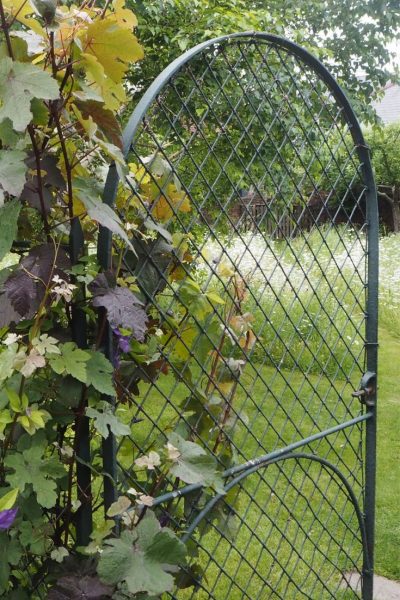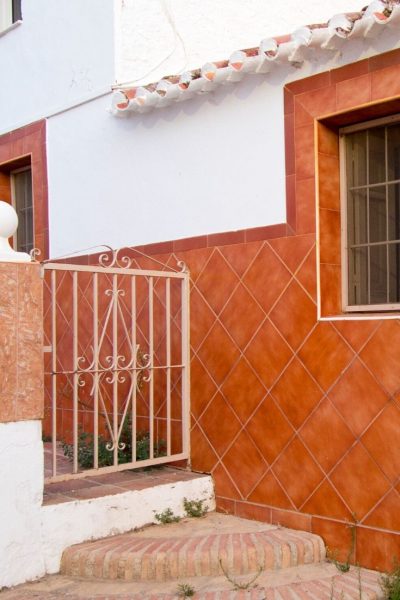[ad_1]
Every time I arrive home and see our garden gate, I’m so pleased that we made it priority when we moved here.
A good garden gate makes a home more inviting.
And it can make a garden more exciting. Garden gates can also help sub-divided your garden into rooms.
You can buy ready made ones from local stores or you can find salvaged, upcycled or antique garden gates.
Or you can get a garden gate tailor-made for your style of house and garden. Although there are a few things you might like to know first.
So, speaking from experience, here goes…
Link your garden gate to your house
This is our garden gate and it is a simple Georgian design because our house is Georgian. We have straight lines and very simple architectural details.
The iron railings and gates were taken away from many houses in Britain during the Second World War. It was hoped that the metal could be used for the war effort. Sadly, it wasn’t usable and much of it was dumped at sea.
So when we first moved into our house sixteen years ago, we didn’t have front railings or a gate.
We could have bought standard railings and a gate, choosing them to be as close to the original design as possible. But we have to get planning permission. The planners didn’t want a Georgian house to have modern railings.
You will need to check what planning permission you might need in your area. For example, if you are in a conservation area, have a listed building or want to build a wall or fence over one metre high, you will need planning permission. And there are other considerations, depending on where you live.
So we had to have our fence and railings made to order. We reckon this cost slightly more than twice as much.
As a project like this will be in the ‘low thousands’ (pounds sterling, dollars etc), this was a very serious consideration. But money spent well on the front of your house is also usually a good long-term investment.
It’s not possible to be more exact on costs as we did this over ten years ago. And the costs will vary according to what you want and where you live.
Where to find inspiration
The architecture of your house is a good starting point for garden gates. As our house was Georgian, the planners wanted us to have a design that was as close as possible to the original.
But how to find out what the original was? We have a friend who was born in this house in 1937. He remembers the day the gate and railings were taken away. But he was only four, so he wasn’t very interested in design details.
Although he does recall that he could crawl under the gate when it was closed, which gave us a good clue as to some of the dimensions! If you have a sloping path or steps, you need to be careful that the bottom of the gate clears them when it opens.

You can’t see the railings and gate very clearly in this photograph, dating from 1900. But added to the marks left in the brick, we could make a good guess.
On the other hand, that will mean quite a gap beneath it when closed. Our dog has wriggled under it a couple of times. Take note if you have toddlers.
We also found a photograph (see above) that showed the overall shape of the railings but it was too blurred to make out much detail.
See houses nearby or local history groups
Even if there are no photographs of your house from the past, you may be able to find photographs of similar streets nearby at your local historic society or library. Or search online.
One house nearby still had its original railings and was a similar age to ours.
And finally, our front garden wall had holes in the brickwork and on stone top, showing where the railings had been. This meant we could work out how far apart they were, and whether they were round or square. And the design of the gate would come from the railings.
Lucie Neame had a slightly different historic journey when creating her garden gate. Her house is a converted farmhouse. It has been changed and added to over the centuries, so it’s not clear exactly which time frame or style would be most appropriate.
She looked at the gates of other older houses nearby to see what sort of gate styles could have been appropriate. Their next door neighbour had an extremely pretty, very old gate.

An ancient Kent farmhouse, which has been through many changes over the centuries. Lucie found a gate style which was both historic and local. It sets the building off beautifully.
She found a local smithy – an artesan who specialised in decorative ironwork. He copied the neighbour’s gate. Lucie had it painted Farrow & Ball’s Blue Grey. It’s charming and appropriate, yet also quite unusual.
However they also had heavy iron farm gates at the entrance to their property. Over ten years later, Lucie wanted new driveway gates to match the front gates. The local smithy was no longer working, so she engaged a company that specialised in making bespoke gates.
Consider the scale…
If you’re adapting a gate pattern from another gate or architectural feature, the scale will change according to the size. Lucie’s driveway gates were bigger and had different proportions to the garden gate.
So when the driveway gates arrived, the ironwork pattern looked different. Instead of a ‘fat boat’ shape, it was more pointed.

Personally I think these driveway gates are beautiful, but Lucie was disappointed when she first saw them because the design has turned out differently. She likes them now.
We, too, found that our front gate wasn’t quite the design we had expected. The gaps between the uprights were different from specified. Mr Middlesize (overseeing the project) wishes he’d visited the smith during the project to check how it was going.
So we would all suggest keeping in touch with the company or the artesan to make sure that you’re getting what you asked for.
It’s also important to check how the gates work. When our front gate arrived, the handle was in the wrong place. If you weren’t careful, it pinched the skin of your hand when you turned the handle. We eventually had this changed, but we should have done it when it first arrived.
Check the gate posts
The gate posts are very important. They will have to support the weight of your gate as it opens and shuts.
So they will have to be set deep into the ground and fixed in place with a concrete post mix. If you already have a gate with gate posts, this may not be a problem. But if you are changing a gate, check whether the new one will be heavier and whether the gate posts can take it.
And if you are planning new electrified driveway gates, you’ll need new gateposts for the electrics.
If you’re changing the gate posts, think about whether they’re in the right place. Lucie’s old farm gate was very close to the road. She decided to move the gate further in, so that people waiting for the electric gates to open wouldn’t block the road.
A few more garden gate ideas…

This is a classic contemporary garden gate – its modern and it’s behind a 1980s house, but its simplicity means it could work with contemporary or historic architecture.

Robin and Margaret Marks combined a traditional picket fence and wrought iron gate in front of their contemporary home. They used a mustard yellow paint to link it all together. More about the design of their garden here.
Buy standard gates…

This is a classic gate design. It’s a style that can be found easily in most parts of the world. Its simplicity works beautifully in this country garden belonging to the artist, Elizabeth Bradley.
Paint your gate…

Many great gardens have a signature colour. You can see this charming blue at Doddington Place Gardens. (open to the public April-September). There are also blue benches – it looks so good when a colour is repeated around the garden.

I like the way this 1950s metal front gate is painted to harmonise with the house. Seen in Spain.
Or leave it natural

This gate at Goodnestone Park Gardens is almost magical. There is something about a door in an old wall…
Use a garden gate to divide the garden

The owner of L’Agapanthe garden in Northern France has divided up his garden with gates and hedges. The garden used to have wide lawns all round the house, but now it has mystery and character through the use of salvaged antique gates and intense planting.

Another antique garden gate at L’Agapanthe. This gate appears not to be used, so the gate is effectively more of a fence. An interesting treatment.
An upcycled garden gate…

This gate at St Erth gardens in Victoria, Australia, is made from old tools. You’d need specialist skills and equipment, so it’s not a cheap option, but it’s fun.
Pin to remember garden gate ideas:

[ad_2]
Source link
